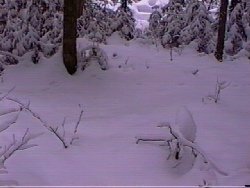
(This is our selected area for the shelter)
Being able to find shelter or to make your own shelter can mean the difference between life or death in a survival situation. During winter or in nasty cold environments, shelter becomes a necessity to survive as it will protect you from the elements. Many articles have been written on this subject: from the Alpha Tent to the debris huts. These make great shelters, but when it gets -30 or -40 degrees they just don't cut it anymore.
This is where snow shelters come into play. Whether you're winter camping or stuck in a survival situation, snow shelters can easily be built (if you have snow). Temperature inside a snow shelter can be 32 degrees or warmer even when the outside temperature is -40 degrees. There are many variations of snow shelters, but one that we use quite often is the "quinzee" also known as the snow hut.
Making a Quinzee
When snow is not deep enough or snow drifts cannot be found, the quinzee is ideal. It's basically a pile of snow in the shape of a dome with the interior hollowed out.
First, you have to select an area in the snow about 6 to 8 feet in diameter with no trees or big rocks in the way.

(This is our selected area for the shelter)
Then, you have two options for building the pile of snow:
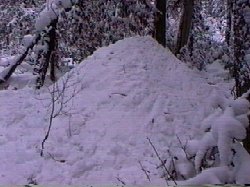
(Our heap of snow is now ready to be hollowed out)
Once the mound has sufficiently hardened, you can start hollowing it to create the inside of the quinzee.
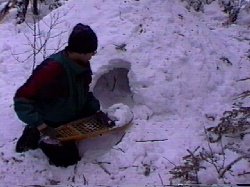
Once the hollowed area is large enough, smooth out the interior and
make it as dome shaped as possible.
Then light a candle on the floor in the middle of the quinzee to glaze
the inner surfaces. Let it burn for 15 to 20 minutes, longer if the shelter
is bigger. This will cut down on dripping while you sleep.
Next, make a few ventilation holes through the top of the dome by using
a long stick. Make sure the holes stay clear of snow and debris. Glazing
the holes with a candle, the same way we did with the interior of the dome,
can help keep the holes clear, but inspecting then regularly is still a
must.
Once the glazing is done, reduce the entrance hole to a size which
will allow access by crawling. Close up the entrance if it's too big. Keep
the entrance as small as possible, barely big enough to let you crawl inside.
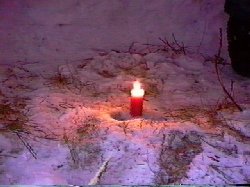
(Glazing inside the the shelter with a candle)
Once you're done working on your shelter let it sit for a while. This will allow the inside of the shelter to harden. Clearly marking the outside of the entrance with sticks or ski poles might be a good thing to do if you leave the site as snow might cover the entrance while you're away. It would be a good idea to cut lots of evergreen boughs or get any other insulating materials while you're waiting for the quinzee to harden. We will be using these for the floor of the quinzee later. When you come back, a thin layer of ice will have formed on the inside walls of the dome (hence the glazing). You can now bring those boughs in and make yourself a nice soft floor. Try to have several inches of insulating materials under you. Again, the more insulation you have, the more you'll be insulated from the cold ground.
When you go inside for the night, block the entrance with your packs, boughs or even with snow. This will help keep the inside warm. Lighting a candle will bring the temperature up real fast inside the quinzee. You might even have to blow your candle out if it gets too warm. While using the candle, be very careful as fire and boughs don't mix too well!!! J
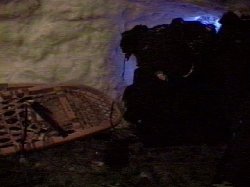
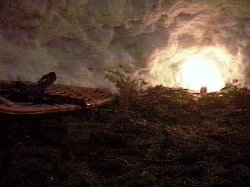
(Inside the quinzee for the night...this should be a comfy one tonight)
Here are a few tips that might help:
Trigger
All materials at this site not otherwise credited are Copyright © 1996-2003 Trip Williams. All rights reserved. May be reproduced for personal use only. Use of any material contained herein is subject to stated terms or written permission.